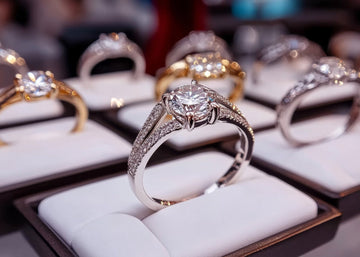Precious Metals Guide
Traditional metals used in jewelry are the “noble metals”: silver, gold and the platinum metal group (including platinum and palladium). Noble metals are so called because of their ability to withstand corrosion and oxidation and their chemical stability. Today's jewelry is more varied and versatile than ever. This is partly due to the use of new types of metals and alloys used to make jewelry.
Through the use of alloys, two or more metals or elements can be combined to give the resulting metallic substance certain properties that are different from its component metals. The primary purpose of alloys in jewelry is to give metals more desirable characteristics. For example, pure gold (24 karat gold) is too soft for prolonged wearing and would scratch easily. Most gold jewelry is either 14 karat gold or 18 karat gold which consists of gold mixed with other alloys, usually silver, nickel, copper or zinc. Sterling silver is silver mixed with alloys to make it stronger. Sterling silver is 92.5% pure silver usually mixed with 7.5% copper.
Metal Purities
| Jewelry Classification | Purity | Noble Metal / Common Alloys |
|---|---|---|
| 24 KARAT (24K) GOLD | 99.90% | PURE GOLD |
| 18 KARAT (18K) GOLD | 75.00% | GOLD WITH NICKEL, COPPER OR ZINC ALLOY |
| 14 KARAT (14K) GOLD | 58.33% | GOLD WITH NICKEL, COPPER OR ZINC ALLOY |
| 10 KARAT (10K) GOLD | 41.66% | GOLD WITH NICKEL, COPPER OR ZINC ALLOY |
| SILVER | 99.90% | PURE SILVER |
| STERLING SILVER | 92.50% | SILVER WITH COPPER ALLOY |
Precious Metal Characteristics
| Metal | Hardness Level (Mohs Scale) | Common Alloys | Pros | Cons |
|---|---|---|---|---|
| 24K YELLOW GOLD | 2.5 | — | BRILLIANT LUSTER | TOO SOFT FOR MOST JEWELRY |
| 18K YELLOW GOLD | 2.75 | SILVER, COPPER, ZINC, NICKEL, PALLADIUM | ALLOYS USED MAKE GOLD MORE DURABLE FOR EVERYDAY WEAR | NICKEL ALLOY CAN HAVE ALLERGENIC PROPERTIES |
| 14K YELLOW GOLD | 3-4 | — | ALLOYS USED MAKE GOLD MORE DURABLE FOR EVERYDAY WEAR | NICKEL ALLOY CAN HAVE ALLERGENIC PROPERTIES |
| WHITE GOLD | 2.8-4.0 | SILVER, PALLADIUM, NICKEL | LESS EXPENSIVE ALTERNATIVE TO PLATINUM | CAN HAVE ALLERGENIC PROPERTIES; RHODIUM PLATING WILL EVENTUALLY WEAR OFF |
| SILVER | 2.5 | COPPER | LOW PRICE POINT | SUSCEPTIBLE TO SCRATCHES |
| PLATINUM | 3.5 | RUTHENIUM, IRIDIUM, PLATINUM | HYPOALLERGENIC, WILL RETAIN WHITE COLOR | SUSCEPTIBLE TO SCRATCHES, PRONGS CAN BEND |
| PALLADIUM | 4.5 | RUTHENIUM, IRIDIUM | HYPOALLERGENIC, MAINTAINS NATURAL WHITE COLOR, GREAT LUSTER ENHANCES GEMS, NATURALLY STRONG METAL, LIGHTER THAN PLATINUM | SUSCEPTIBLE TO SCRATCHES, MORE SENSITIVE TO ACIDS, WON'T TAKE A HIGH POLISH WELL |
| TUNGSTEN CARBIDE | 9 | CARBON | HYPOALLERGENIC, LOW PRICE POINT, MAINTAINS WHITE COLOR FOREVER, LOOKS GREAT AFTER YEARS OF WEAR | NOT A PRECIOUS METAL, CAN CHIP OR SHATTER, CAN OXIDIZE; CANNOT BE SIZED |
| TUNGSTEN | 7.5 | — | HYPOALLERGENIC, RESISTS SCRATCHES, ESPECIALLY USEFUL FOR BRUSHED JEWELRY DESIGNS | NOT A PRECIOUS METAL; CANNOT BE SIZED |
| STAINLESS STEEL | 6.5 | CARBON, IRON | RESISTS CORROSION AND STAINING | NOT A PRECIOUS METAL; CANNOT BE SIZED |
| TITANIUM | 6 | ALUMINUM, IRON, TIN | HYPOALLERGENIC, HIGH TENSILE STRENGTH, RESISTS CORROSION, LIGHT WEIGHT | SUSCEPTIBLE TO SCRATCHES; CANNOT BE SIZED |


